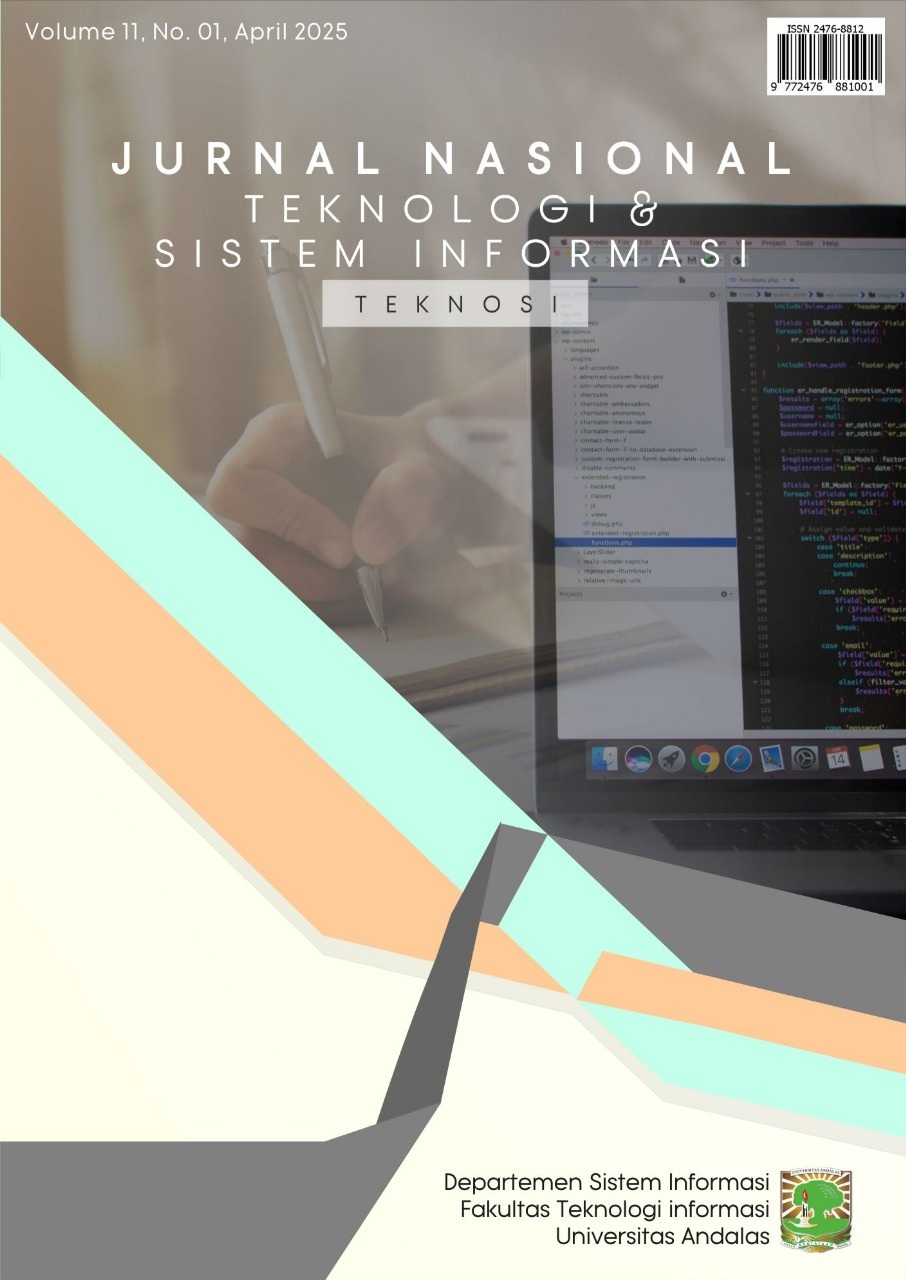Perbandingan Arsitektur CNN Berbasis Transfer Learning untuk Klasifikasi pada BreastMNIST
DOI:
https://doi.org/10.25077/TEKNOSI.v11i2.2025.192-200Kata Kunci:
CNN, Kanker Payudara, Klasifikasi, Transfer Learning, UltrasonografiAbstrak
Kanker payudara adalah salah satu penyebab utama kematian di kalangan Wanita, terutama di negara berkembang seperti Indonesia. Deteksi dini sangat penting untuk meningkatkan tingkat kesembuhan dan menurunkan angka kematian. Penelitian ini bertujuan untuk meningkatkan kemampuannya dalam mengidentifikasi tumor kanker dengan memaksimalkan nilai recall serta membandingkan berbagai model Convolutional Neural Network (CNN) berbasis transfer learning guna menemukan model yang paling optimal. Arsitektur CNN yang dikaji dalam penelitian ini meliputi MobileNetV2, ResNet50, VGG16, dan AlexNet. Seluruh model diterapkan pada dataset BreastMNIST, yang terdiri dari citra ultrasonografi dengan dua kelas, yaitu jinak dan ganas. Transfer learning digunakan untuk mengatasi tantangan akibat keterbatasan ketersediaan data citra medis yang telah diberi label. Kinerja model dievaluasi secara menyeluruh menggunakan metrik akurasi, presisi, recall, F1-score dan Area Under Curve (AUC). Hasil penelitian menunjukkan bahwa MobileNetV2 memberika performa yang unggul dengan akurasi sebesar 91,14%, recall 94%, presisi 93%, F1-score 94%, dan AUC sebesar 0,9607. Temuan ini mengindikasikan bahwa MobileNetV2 berbasis transfer learning sangat efektif dalam mendeteksi tumor ganas dan merupakan arsitektur paling optimal dalam studi ini.Referensi
A. V. Icanervilia et al., “Early Detection of Breast Cancer in Indonesia: Barriers Identified in a Qualitative Study,” Asian Pacific J. Cancer Prev., vol. 24, no. 8, pp. 2749–2755, 2023, doi: 10.31557/APJCP.2023.24.8.2749.
R. Resmiati and T. Arifin, “Klasifikasi Pasien Kanker Payudara Menggunakan Metode Support Vector Machine dengan Backward Elimination,” Sistemasi, vol. 10, no. 2, p. 381, 2021, doi: 10.32520/stmsi.v10i2.1238.
T. Arifin, I. W. P. Agung, E. Junianto, R. Rachman, I. R. Wibowo, and D. D. Agustin, “Breast cancer identification using machine learning and hyperparameter optimization,” Indones. J. Electr. Eng. Comput. Sci., vol. 36, no. 3, pp. 1620–1630, 2024, doi: 10.11591/ijeecs.v36.i3.pp1620-1630.
L. Wilkinson and T. Gathani, “Understanding Breast Cancer as A Global Health Concern,” Br. J. Radiol., vol. 95, no. 1130, pp. 7–9, 2022, doi: 10.1259/BJR.20211033.
T. K. Dewi, R. A. C. Ruiter, R. Ardi, and K. Massar, “The role of psychosocial variables in breast self-examination practice: Result from focus group discussions in Surabaya, Indonesia,” 2022.
L. Choridah, A. V. Icanervilia, A. A. Rengganis, J. At Thobari, M. J. Postma, and A. D.I. van Asselt, “Comparing the performance of three modalities of breast cancer screening within a combined programme targeting at-risk women in Indonesia: An implementation study,” Glob. Public Health, vol. 18, no. 1, 2023, doi: 10.1080/17441692.2023.2284370.
S. F. Ahmed et al., Deep learning modelling techniques: current progress, applications, advantages, and challenges, vol. 56, no. 11. Springer Netherlands, 2023. doi: 10.1007/s10462-023-10466-8.
S. Balasubramaniam, Y. Velmurugan, D. Jaganathan, and S. Dhanasekaran, “A Modified LeNet CNN for Breast Cancer Diagnosis in Ultrasound Images,” Diagnostics, vol. 13, no. 17, pp. 1–28, 2023, doi: 10.3390/diagnostics13172746.
I. D. Mienye and T. G. Swart, “A Comprehensive Review of Deep Learning Methods and Applications,” Deep Learn. Vis. Underst., pp. 7–58, 2024, [Online]. Available: https://linkinghub.elsevier.com/retrieve/pii/S0925231215017634
G. Chhabra, S. Kumar, D. S. Raha, and D. G. C. Saha, “Analysis of Deep Learning in Real-World Applications: Challenges and Progress,” Tuijin Jishu/Journal Propuls. Technol., vol. 44, no. 2, pp. 281–289, 2023, doi: 10.52783/tjjpt.v44.i2.150.
R. Du, Y. Chen, T. Li, L. Shi, Z. Fei, and Y. Li, “Discrimination of Breast Cancer Based on Ultrasound Images and Convolutional Neural Network,” J. Oncol., vol. 2022, 2022, doi: 10.1155/2022/7733583.
M. D. Ali et al., “Breast Cancer Classification through Meta-Learning Ensemble Technique Using Convolution Neural Networks,” Diagnostics, vol. 13, no. 13, 2023, doi: 10.3390/diagnostics13132242.
A. Al Tawil, A. Shaban, and L. Almazaydeh, “A comparative analysis of convolutional neural networks for breast cancer prediction,” Int. J. Electr. Comput. Eng., vol. 14, no. 3, pp. 3406–3414, 2024, doi: 10.11591/ijece.v14i3.pp3406-3414.
O. Özkaraca et al., “Multiple Brain Tumor Classification with Dense CNN Architecture Using Brain MRI Images,” Life, vol. 13, no. 2, 2023, doi: 10.3390/life13020349.
S. Arooj et al., “Breast Cancer Detection and Classification Empowered With Transfer Learning,” Front. Public Heal., vol. 10, no. July, pp. 1–18, 2022, doi: 10.3389/fpubh.2022.924432.
M. Zourhri, S. Hamida, N. Akouz, B. Cherradi, H. Nhaila, and M. El Khaili, “Deep Learning Technique for Classification of Breast Cancer using Ultrasound Images,” 2023 3rd Int. Conf. Innov. Res. Appl. Sci. Eng. Technol. IRASET 2023, no. April 2024, 2023, doi: 10.1109/IRASET57153.2023.10153069.
A. AlZoubi, F. Lu, Y. Zhu, T. Ying, M. Ahmed, and H. Du, “Classification of breast lesions in ultrasound images using deep convolutional neural networks: transfer learning versus automatic architecture design,” Med. Biol. Eng. Comput., vol. 62, no. 1, pp. 135–149, 2024, doi: 10.1007/s11517-023-02922-y.
V. Azevedo, C. Silva, and I. Dutra, “Quantum transfer learning for breast cancer detection,” Quantum Mach. Intell., vol. 4, no. 1, 2022, doi: 10.1007/s42484-022-00062-4.
M. Alruwaili and W. Gouda, “Automated Breast Cancer Detection Models Based on Transfer Learning,” Sensors, vol. 22, no. 3, 2022, doi: 10.3390/s22030876.
A. W. Salehi et al., “A Study of CNN and Transfer Learning in Medical Imaging: Advantages, Challenges, Future Scope,” Sustain., vol. 15, no. 7, 2023, doi: 10.3390/su15075930.
F. Uysal and M. M. Köse, “Classification of Breast Cancer Ultrasound Images with Deep Learning-Based Models †,” Eng. Proc., vol. 31, no. 1, 2022, doi: 10.3390/ASEC2022-13791.
N. Matondo-Mvula and K. Elleithy, “Breast Cancer Detection with Quanvolutional Neural Networks,” Entropy, vol. 26, no. 8, 2024, doi: 10.3390/e26080630.
J. Yang et al., “MedMNIST v2 - A large-scale lightweight benchmark for 2D and 3D biomedical image classification,” Sci. Data, vol. 10, no. 1, pp. 1–10, 2023, doi: 10.1038/s41597-022-01721-8.
A. B. M. A. Hossain, J. K. Nisha, and F. Johora, “Breast Cancer Classification from Ultrasound Images using VGG16 Model based Transfer Learning,” Int. J. Image, Graph. Signal Process., vol. 15, no. 1, pp. 12–22, 2023, doi: 10.5815/ijigsp.2023.01.02.
M. Krichen, “Convolutional Neural Networks: A Survey,” Computers, vol. 12, no. 8, pp. 1–41, 2023, doi: 10.3390/computers12080151.
J. Alyami et al., “Cloud Computing-Based Framework for Breast Tumor Image Classification Using Fusion of AlexNet and GLCM Texture Features with Ensemble Multi-Kernel Support Vector Machine (MK-SVM),” Comput. Intell. Neurosci., vol. 2022, 2022, doi: 10.1155/2022/7403302.
S. Mohapatra, S. Muduly, S. Mohanty, J. V. R. Ravindra, and S. N. Mohanty, “Evaluation of deep learning models for detecting breast cancer using histopathological mammograms Images,” Sustain. Oper. Comput., vol. 3, no. March, pp. 296–302, 2022, doi: 10.1016/j.susoc.2022.06.001.
P. Ashwini, N. Suguna, and N. Vadivelan, “Detection and classification of breast cancer types using VGG16 and ResNet50 deep learning techniques,” Int. J. Electr. Comput. Eng., vol. 14, no. 5, pp. 5481–5488, 2024, doi: 10.11591/ijece.v14i5.pp5481-5488.
D. Shah, M. A. U. Khan, M. Abrar, and M. Tahir, “Optimizing Breast Cancer Detection With an Ensemble Deep Learning Approach,” Int. J. Intell. Syst., vol. 2024, no. 1, 2024, doi: 10.1155/2024/5564649.
J. Lee, J. Park, and Y. Lee, “Towards Efficient Cancer Detection on Mobile Devices,” IEEE Access, vol. 13, no. February, pp. 34613–34626, 2025, doi: 10.1109/ACCESS.2025.3543838.
Y. F. Khan, A. Runani, and B. Ahmed Mir, “Swarm-driven fine-tuned hybrid transfer learningarchitecture on breast ultrasound scans for advanced prognostic,” Int. J. Inf. Technol., no. December 2024, 2024, doi: 10.1007/s41870-024-02329-4.
T. Yang and Y. Ying, “AUC Maximization in the Era of Big Data and AI: A Survey,” ACM Comput. Surv., vol. 55, no. 8, 2022, doi: 10.1145/3554729.
Unduhan
Telah diserahkan
Diterima
Diterbitkan
Cara Mengutip
Terbitan
Bagian
Lisensi
Hak Cipta (c) 2025 Jurnal Nasional Teknologi dan Sistem Informasi

Artikel ini berlisensiCreative Commons Attribution-ShareAlike 4.0 International License.
Hak cipta untuk artikel ini ditransfer ke Jurnal Nasional Teknologi dan Sistem Informasi (TEKNOSI) jika dan ketika artikel diterima untuk publikasi. Yang bertanda tangan di bawah ini dengan ini mentransfer setiap dan semua hak di dalam dan ke kertas termasuk tanpa batasan semua hak cipta untuk TEKNOSI. Yang bertanda tangan di bawah ini dengan ini menyatakan dan menjamin bahwa makalah tersebut asli dan bahwa ia adalah pembuat makalah, kecuali untuk bahan yang secara jelas diidentifikasi sebagai sumber aslinya, dengan pemberitahuan izin dari pemilik hak cipta jika diperlukan. Yang bertanda tangan di bawah ini menyatakan bahwa ia memiliki kekuatan dan wewenang untuk membuat dan melaksanakan penugasan ini.
Kami menyatakan bahwa:
- Makalah ini belum diterbitkan dalam bentuk yang sama di tempat lain.
- Makalah ini tidak akan dikirimkan di tempat lain untuk publikasi sebelum penerimaan/penolakan oleh Jurnal ini
- Izin hak cipta diperoleh untuk materi yang diterbitkan di tempat lain dan yang memerlukan izin ini untuk reproduksi.
Selanjutnya, Saya/kami dengan ini mentransfer hak publikasi yang tidak terbatas dari makalah yang disebutkan di atas secara keseluruhan kepada TEKNOSI. Transfer hak cipta mencakup hak untuk mereproduksi dan mendistribusikan artikel, termasuk cetak ulang, terjemahan, reproduksi foto, mikroform, bentuk elektronik (offline, online) atau reproduksi lain yang serupa.
Penulis yang sesuai menandatangani dan menerima tanggung jawab untuk merilis materi ini atas nama setiap dan semua penulis bersama. Perjanjian ini harus ditandatangani oleh setidaknya salah satu penulis yang telah memperoleh persetujuan dari rekan penulis jika berlaku. Setelah pengajuan perjanjian ini ditandatangani oleh penulis yang sesuai, perubahan kepengarangan atau dalam urutan penulis yang tercantum tidak akan diterima.
Hak / Syarat dan Ketentuan yang dipertahankan :
- Penulis memiliki semua hak kepemilikan dalam setiap proses, prosedur, atau artikel manufaktur yang dijelaskan dalam Karya ini.
- Penulis dapat mereproduksi atau mengotorisasi orang lain untuk mereproduksi karya ini atau karya turunannya untuk penggunaan pribadi penulis atau untuk penggunaan perusahaan, dengan ketentuan bahwa sumber dan menyatakan hak cipta dimiliki TEKNOSI, salinan tidak digunakan dengan cara apa pun yang menyiratkan pengesahan TEKNOSI atas suatu produk atau layanan dari pihak mana pun, dan salinannya sendiri tidak ditawarkan untuk dijual.
- Meskipun penulis diizinkan untuk menggunakan kembali semua atau sebagian dari karya ini dalam karya lain, ini tidak termasuk mengabulkan permintaan pihak ketiga untuk mencetak ulang, menerbitkan ulang, atau jenis penggunaan ulang lainnya.














